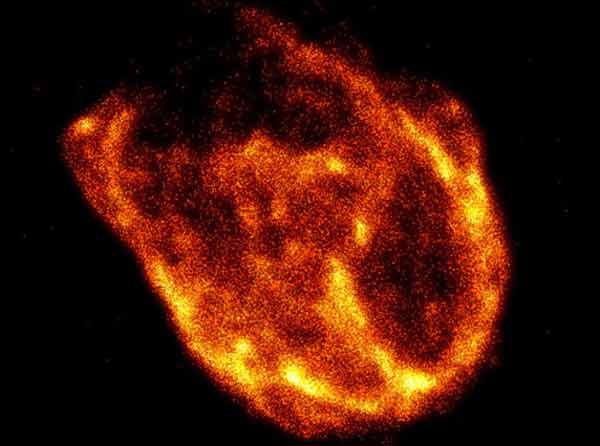Credit & Copyright: Chandra X-ray Observatory,
NASA
Explanation:
Thousands of years after a star explodes,
an expanding remnant may still glow brightly.
Such is the case with
N132D, a
supernova remnant
located in the neighboring
Large Magellanic Cloud galaxy.
The expanding shell
from this explosion now spans 80
light-years and has swept up about 600 Suns worth of mass.
The bright regions surrounding the lower right of this
X-ray image result from a collision with an even more massive
molecular cloud.
Towards the upper left, the
supernova remnant expands more rapidly into
less dense region of space.
This image is one of the first ever taken with the
High Resolution Camera onboard the orbiting
Chandra X-ray Observatory,
and records details being analyzed for the first time.
1999 2000 2001 2002 2003 2004 2005 2006 2007 2008 2009 2010 2011 2012 2013 2014 2015 2016 2017 2018 2019 2020 2021 2022 2023 2024 2025 |
Yanvar' Fevral' Mart Aprel' Mai Iyun' Iyul' Avgust Sentyabr' Oktyabr' Noyabr' Dekabr' |
NASA Web Site Statements, Warnings, and Disclaimers
NASA Official: Jay Norris. Specific rights apply.
A service of: LHEA at NASA / GSFC
& Michigan Tech. U.
|
Publikacii s klyuchevymi slovami:
supernova remnant - supernova - ostatok Sverhnovoi - vzryvy sverhnovyh - rentgenovskie nablyudeniya
Publikacii so slovami: supernova remnant - supernova - ostatok Sverhnovoi - vzryvy sverhnovyh - rentgenovskie nablyudeniya | |
Sm. takzhe:
Vse publikacii na tu zhe temu >> | |
